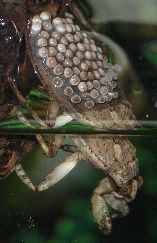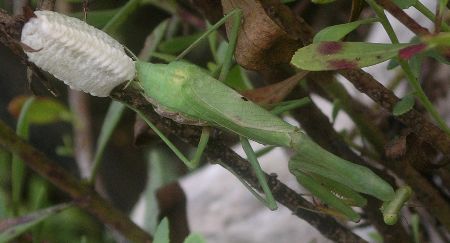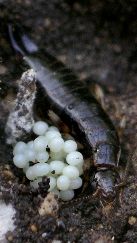 male giant water bug with eggs |  Carolina mantis laying eggs |  female earwig with eggs |
Before digital photography, I never paid much attention to insect eggs. They were simply too small for the kind of close observation I enjoy. I want to be able to study my subjects, get to know and understand them, and learn something I didn't know before, but the lack of convenient magnification was a huge barrier. I could see there were eggs, yet their details remained a total mystery.
Now that I have a tool which allows me to see them, I've begun to unravel some of the riddles of the tiny eggs. It has been a slow process. Not only do I need to find the darn things in the first place, but then I have to figure out what sort of insect they might be. Many eggs are hidden or camouflaged to keep them safe from predators. I'm not the most patient person, so simply collecting eggs and waiting for them to hatch is not particularly practical. I am reluctant to disturb them. I might move those eggs from a perfect habitat that their mother had selected. Then I would have the responsibility of putting the babies back where I found them, if I could remember. I might not even be able to recognize what kind of insect the babies are! And if I forget about them completely, they might hatch out and then starve to death before I could release them.
One other little obstacle is the lack of information on identifying eggs. Obviously, there are no "Field Guide to Insect Eggs" books. It might come as a surprise, but there is just not a large market for such a resource. However, there are plenty of clues and tidbits scattered here and there, in various biology books as well as on the internet. If one knows where to look, is persistent, and likes to solve mysteries, then insect eggs provide a worthwhile subject.
 male giant water bug with eggs |  Carolina mantis laying eggs |  female earwig with eggs |
Sometimes, I see the adult insect actually laying the eggs. Then there is little doubt about their identity. In fact, seeing an insect ovipositing is one of those rare events that make insect-watching far more fascinating than simply looking at stationary specimens. It is on a par with observing insects mate, molt, or eat each other. For most species, laying eggs is a one-time affair; it is the zenith of their existence and, once they have provided for the next generation, they expire. Many females live longer than males simply because they need more time to do their bit for the continuation of the species.
Although most insects merely lay eggs and leave them, a few actually hang around and protect their clutches. The males of some giant water bugs carry the eggs around on their backs. Who would think of insects as such good parents? Among those that go the extra mile to defend their eggs are a few stink bugs, cockroaches, and earwigs. Scale insects, that we see on plants in all their strange forms, are mostly females with their eggs. They are usually encased within waxy secretions, powdery deposits, fuzzy bundles, or armored shells, but sometimes the female's own body serves as the nursery. When you squish a little white cochineal insect on cactus to see the famous red color, you are really destroying a whole family of tiny insects.
 acanaloniid planthopper laying eggs in a grass stem |  owlfly eggs with ant-repellent barrier |
Social insects (wasps, bees, ants, and termites) have developed an entire way of life around the protection and rearing of their eggs. No egg is better defended than that of a honey bee, with hundreds of related females close at hand who will give their lives to protect it. In fact, the ovipositor (egg-laying structure on female insects) is what eventually evolved into the stinger that only female wasps, bees, and ants possess.
Even insects that simply leave their eggs on their own often invest extra resources in order to give their progeny the best chance of survival. Dragonflies and damselflies might actually submerge as they crawl down a plant stem to lay their eggs underwater. Some wasps enter the burrows of grubs in order to lay their eggs directly on their victims. Various beetles gird twigs in order to create the dead wood that their grubs need to mature. Leafhoppers cover their eggs with a special waxy secretion. Dung beetles roll those little balls of poop just so their young have an ample supply of food when they hatch. All manner of insects dig burrows, build nests, excavate tunnels in wood or carefully search for the optimum place to lay their eggs. They might pack a nest or cavity with provisions for the young such as pollen or paralyzed spiders.
 geometrid moth eggs on strand of spider web silk |
One other consideration that insects have when laying eggs is placement. Should they be bunched up or spread out? Of course, this is all instinct, but the variety of arrangements is rather amazing. Packed spheres naturally fall into hexagonal shapes, and eggs laid on sticks tend to be in a line, but some insects lay their eggs in rows, regardless of surface configuration, or in double rows. They might be barely touching each other or in a pile. Some space them out but still leave them in a group. If the eggs are in a group, there is the option of a protective coating. Mantis egg cases are sturdy enough to last not only through the winter but often for a couple more years after the eggs have hatched!
A few insects provide rather unusual structures to protect their eggs. Green lacewing eggs are easily and often seen - they are white oval shapes on a very slender hair-like stalk. They might be laid individually or in short rows, all neatly spaced from each other. The stalk deters ants and other crawling predators. Even more elaborate measures are taken by a relative of the lacewing, the owlfly. The female lays her eggs in two rows at the tip of a long and slender twig, thorn or leaf. She then produces a barrier of short stalks a little farther down the stem from the eggs. These are arranged in a close spiral that goes around the stem at least six or more times. The stalks (actually undeveloped eggs), called repagula, are coated with a sticky substance that repels ants.
 coreid bug eggs |  newly emerged scelionid wasps with stink bug eggs |
Why do eggs need protection? They face a number of predators, some of which are obviously animals that feast on the eggs. Fungus and bacteria are also of concern, as are minute parasitoid wasps that lay their eggs in relatively larger ones. It is mind boggling, but there are wasps tiny enough to complete their entire life cycles within the eggs of other insects. There are also plenty of insects that lay their eggs in the carefully prepared nests of other insects, so that their eggs might hatch first, in order to eat either the rightful owners' eggs or the stash of food left for them.
All the biology aside, insect eggs are endlessly diverse in many aspects. The shape can take just about any form, such as round, flat, barrel-shaped or oval, that allows the nymph or larva to develop inside. Eggs might be laid singly or in groups, rows, or clusters. They might be covered with a protective shelter, such as silk, debris, or foam. They can be on twigs, leaves, or the siding of a house. I've seen moth eggs laid on a strand of spider web silk. Some eggs are laid in the ground, into stems of plants, or underwater. Since there are more insects than any other living things, it is safe to assume that there are more insect eggs than we ever imagine. As an absorbing aspect of nature to study, insect eggs fully live up to their potential.
| More Tiny Eggs |